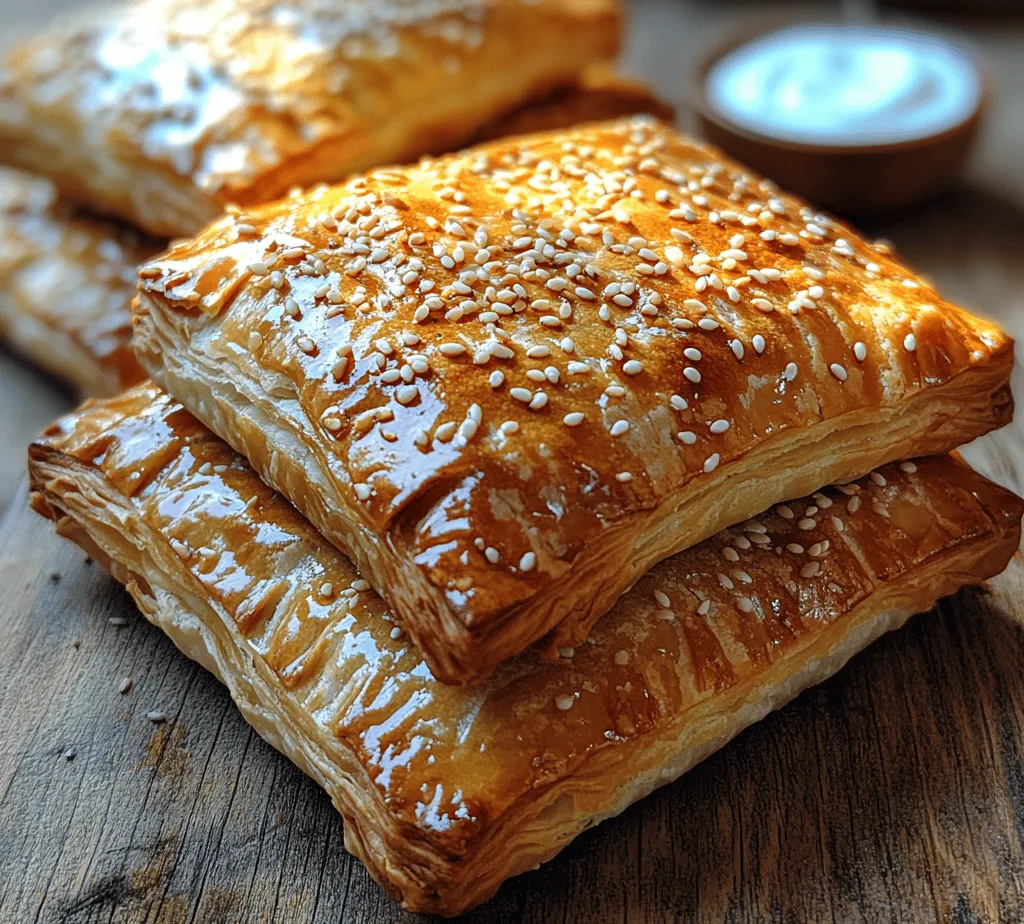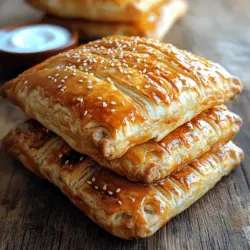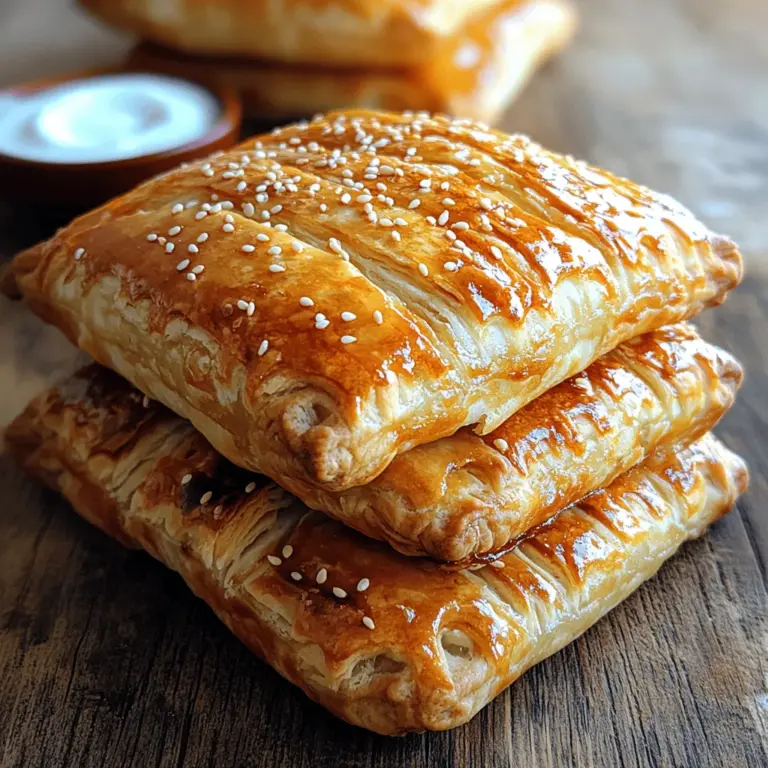Introduction to Flaky Arabic Dough Delight
Step into the enchanting world of Flaky Arabic Dough Delight, a culinary gem that embodies the rich flavors and traditions of Middle Eastern cooking. This remarkable pastry dough is celebrated for its delicate, buttery texture and versatility, making it a beloved foundation for both savory and sweet dishes. From the iconic pastries of baklava to the savory bites of meat pies, this dough promises to elevate your culinary creations to new heights.
In this article, we will explore the history and significance of Arabic pastry, the key ingredients that contribute to the perfect flaky dough, and provide you with a step-by-step guide to making it at home. Whether you’re a seasoned baker or a novice in the kitchen, mastering this dough will unlock a myriad of possibilities for delightful dishes that are sure to impress.
Understanding the Origins of Arabic Dough
Historical Significance of Arabic Pastry
Pastries hold a special place in Middle Eastern cuisine, reflecting a rich tapestry of cultural influences and historical significance. The tradition of pastry-making dates back centuries, with roots in the ancient civilizations of the region. As trade routes flourished, the exchange of spices, techniques, and flavors enriched local cooking practices, leading to the development of diverse pastry forms.
In Middle Eastern culture, pastries are not merely food; they are a symbol of hospitality and celebration. From weddings to religious festivals, flaky pastries have long been prepared to honor guests and mark special occasions. This cultural importance is evident in the intricate designs and elaborate presentations that characterize many Middle Eastern pastries, each telling a story of craftsmanship and tradition.
Varieties of Arabic Dough
Arabic cuisine features an array of doughs, each tailored for specific dishes and textures. While there are various types, flaky Arabic dough stands out due to its unique characteristics and adaptability. Unlike denser doughs such as bread or pizza crust, flaky Arabic dough is crafted to be light and airy, resulting in a delightful crunch that complements both sweet and savory fillings.
In comparison to other Middle Eastern doughs, such as the stretchy dough used for manakish or the rich pastry dough found in kunafa, flaky Arabic dough is distinct in its preparation and texture. It relies on the careful incorporation of fat, typically butter, to achieve its signature flakiness, while also utilizing yogurt and lemon juice to enhance its flavor and tenderness.
Key Ingredients for Flaky Arabic Dough
To create the perfect Flaky Arabic Dough, it is essential to use high-quality ingredients that will work harmoniously together. Below are the key components that contribute to the dough’s delightful texture and taste.
All-Purpose Flour
The foundation of any great dough starts with flour, and for flaky Arabic dough, all-purpose flour is the ideal choice. The quality and type of flour used can significantly affect the consistency and texture of the final product. When selecting flour, look for a brand that is finely milled and has a moderate protein content. This balance allows for the dough to develop enough gluten to hold its shape while still remaining tender and flaky.
Unsalted Butter
Butter is the star ingredient when it comes to achieving that coveted flaky texture in Arabic dough. The rich, creamy flavor of unsalted butter not only enhances the taste but also contributes to the dough’s lightness. When incorporating butter into the flour, it’s essential to use cold, high-quality butter for optimal results. The cold butter creates pockets of steam during baking, which ultimately leads to the flaky layers that define this dough.
When selecting butter, choose a brand that uses minimal additives and focuses on natural ingredients. This ensures that you are getting the best flavor and quality for your pastry-making endeavors.
Yogurt and Lemon Juice
Yogurt and lemon juice are unconventional yet vital ingredients in flaky Arabic dough. Yogurt adds moisture and a slight tang to the dough, which helps to create a tender texture. Its acidity also interacts with the flour to create a softer gluten structure, resulting in a more delicate pastry.
Incorporating lemon juice not only enhances the flavor of the dough but also contributes to its overall tenderness. The acidity in lemon juice works in tandem with yogurt, ensuring that the dough remains light and flaky. Additionally, yogurt brings nutritional benefits, including protein and probiotics, making your pastries not just delicious but also a bit healthier.
Water and Salt
Water is essential for hydrating the flour and bringing the dough together. The right amount of water will ensure that the dough is neither too dry nor too sticky, facilitating easy handling and shaping. When adding water, do so gradually, mixing until the dough just comes together.
Salt is another crucial ingredient that enhances the flavor of the dough. A small amount of salt can make a significant difference, elevating the overall taste of your pastries. It’s important to note that too much salt can overpower the delicate flavors, so stick to the recommended amount for best results.
Step-by-Step Guide to Making Flaky Arabic Dough
Now that we’ve explored the origins and key ingredients of Flaky Arabic Dough, it’s time to dive into the process of making this delightful pastry base. Follow these detailed instructions to create your own flaky dough that is perfect for both sweet and savory applications.
Preparing the Dough Base
1. Gather Your Ingredients: Start by measuring out all your ingredients accurately. You will need all-purpose flour, unsalted butter, yogurt, lemon juice, salt, and water.
2. Mix the Dry Ingredients: In a large mixing bowl, combine the all-purpose flour and salt. Whisk them together to ensure they are evenly distributed. This step is crucial as it helps to create a uniform dough.
3. Create a Flour Mixture: Once the flour and salt are well combined, create a well in the center of the flour mixture. This is where you will add the butter and wet ingredients later.
Incorporating Butter for Flakiness
4. Cutting in the Butter: Take your cold unsalted butter and cut it into small cubes. Add the cubes to the flour mixture. Using a pastry cutter, fork, or your fingertips, work the butter into the flour until the mixture resembles coarse crumbs. Aim for a consistency where there are still small pieces of butter visible—this is key to achieving flakiness.
5. Avoid Overworking the Dough: One common mistake when making flaky dough is overworking the mixture. Be gentle and quick in your movements, as excessive handling can develop the gluten too much, resulting in a tougher texture.
Adding Yogurt and Lemon Juice
6. Incorporate Wet Ingredients: In a separate bowl, combine the yogurt and lemon juice. Stir them together until smooth. Gradually add this mixture to the flour and butter blend, using a spatula or your hands to combine them gently.
7. Form the Dough: Add water, one tablespoon at a time, mixing until the dough starts to come together. The goal is to achieve a slightly sticky yet manageable dough. If the dough feels too dry, add a bit more water; if it is too wet, sprinkle in a little extra flour.
Chilling the Dough
8. Shape and Wrap: Once the dough has come together, shape it into a disc. Wrap it tightly in plastic wrap to prevent it from drying out. Chilling the dough is a crucial step as it allows the gluten to relax and the butter to firm up, which will enhance the flakiness of the pastry.
9. Refrigerate: Place the wrapped dough in the refrigerator for at least 30 minutes. This resting period is essential for the flavors to meld and the dough to achieve the desired texture.
By following these steps, you will create a deliciously flaky Arabic dough that can serve as a base for an array of culinary delights. In the next part of this article, we will explore the various ways to use this dough, from savory pastries to sweet treats, allowing you to fully appreciate the versatility and charm of this delightful pastry.

Chilling is a critical step in the pastry-making process, especially for creating the perfect flaky texture in your Arabic dough. When you chill the dough, it allows the butter (or any fat) to firm up after being mixed in. This is vital because when the fat is cold, it doesn’t fully incorporate into the flour, creating pockets of fat that will eventually melt during baking. As these pockets melt, they create steam, leading to the flaky layers that are characteristic of this delightful pastry.
Recommended Chilling Times and Methods
For optimal results, it’s recommended to chill your flaky Arabic dough for at least 30 minutes to 1 hour in the refrigerator. If you have the time, chilling overnight will yield even better results. Wrap the dough tightly in plastic wrap to prevent it from drying out and to allow the flavors to meld. If you’re short on time, you can also place the dough in the freezer for about 15-20 minutes; just be cautious not to freeze it solid, as you’ll want it pliable enough to roll out.
Rolling and Folding Techniques
Once your dough has chilled, it’s time to roll it out. Begin by lightly flouring your work surface and your rolling pin to prevent sticking. Take the chilled dough and place it on the floured surface. Start rolling from the center outwards, applying even pressure to create a rectangle about 1/4 inch thick.
The folding technique is equally important in developing the flakiness. After rolling out your dough, fold it into thirds like a letter—this is known as a “turn.” Rotate the dough 90 degrees, roll it out again, and repeat the folding process. Aim for 3-4 turns, which helps create layers that will puff up during baking. This method is essential as it contributes to the final flakiness, as each fold creates additional layers of dough and fat, resulting in a beautifully flaky pastry.
Final Chilling Before Use
Before you proceed to shape your pastries, give the rolled dough another short chill in the refrigerator for about 15-20 minutes. This final chill is crucial because it helps to relax the gluten that has developed during rolling, preventing the dough from shrinking while baking. It also keeps the fat cold, ensuring that the final result is as flaky as possible.
Creative Uses for Flaky Arabic Dough
The versatility of flaky Arabic dough allows it to shine in both savory and sweet applications, making it an excellent choice for a variety of dishes.
Savory Applications
For savory fillings, consider using spiced meats such as minced lamb or beef mixed with aromatic spices like cumin, coriander, and cinnamon. You can also incorporate sautéed vegetables, such as spinach, mushrooms, or bell peppers, to create a hearty filling. Traditional dishes that utilize flaky Arabic dough include sambousek, which are delightful pastries filled with meat or vegetables and fried to a golden crisp.
Another popular option is to make fatayer, a Lebanese pastry often filled with spinach or cheese. The flaky dough provides the perfect texture to complement the savory fillings, allowing each bite to offer a satisfying crunch.
Sweet Applications
When it comes to sweet fillings, the possibilities are endless. Consider using a mixture of finely chopped nuts, like pistachios or walnuts, combined with sugar and spices such as cinnamon or cardamom. You can also incorporate fruits like apples or pears, which pair beautifully when baked inside the flaky dough.
Traditional desserts that can be made using flaky Arabic dough include baklava, where layers of dough are filled with nuts and sweetened with syrup, and qatayef, a stuffed pastry commonly served during Ramadan. These sweet applications showcase the adaptability of the dough while providing a delightful taste experience.
Baking with Flaky Arabic Dough
Preparing for Baking
Before you bake your delicious pastries, ensure your oven is preheated to the appropriate temperature—usually around 375°F to 400°F (190°C to 200°C). This range allows for even cooking and helps achieve that desirable golden-brown finish.
When filling your pastries, be careful not to overstuff them, as this can lead to bursting during baking. A good rule of thumb is to leave a small border around the edges. After filling, use water to moisten the edges, then fold and seal securely. You can crimp the edges with a fork or twist them to create a decorative finish.
Baking Techniques
For best results, bake your pastries on a parchment-lined baking sheet to prevent sticking. Depending on the size and type of pastry, baking times may vary, but they generally range from 20 to 30 minutes. Keep an eye on them as they bake; you’re looking for a beautifully golden exterior and a crisp texture.
To know when your pastries are done, look for a rich golden color and listen for a light crunch when tapping the surface. If you’re unsure, you can insert a toothpick into the center; it should come out clean without any raw filling attached.
Achieving the Perfect Golden Brown Finish
Achieving that perfect golden-brown finish is easier than you might think. The key is to monitor the color closely as your pastries bake. If you notice they are browning too quickly, consider lowering the oven temperature slightly.
For an extra touch of elegance, you can brush the tops of your pastries with an egg wash (a mixture of beaten egg and water) before baking. This will give them a beautiful sheen and enhance the golden color. For those wishing to elevate presentation further, consider garnishing with a sprinkle of powdered sugar or a drizzle of honey after they have cooled slightly.
Nutritional Profile and Benefits of Flaky Arabic Dough
Caloric and Nutritional Breakdown
Understanding the nutritional profile of flaky Arabic dough can help you appreciate the balance it offers within your meals. The primary ingredients—flour, butter, and water—contribute to the caloric content. On average, a serving of flaky dough can range from 150 to 200 calories, depending on the size and additional ingredients used for fillings.
The use of natural ingredients in homemade pastries not only supports a more wholesome diet but also allows you to control what goes into your food. By avoiding preservatives and artificial additives commonly found in store-bought options, you can enjoy your pastries with peace of mind.
Healthier Alternatives
For those looking to modify the recipe for dietary preferences, there are several options to consider. If you need a gluten-free dough, consider using a gluten-free flour blend that contains xanthan gum to help mimic the elasticity of traditional flour. Alternatively, using whole wheat flour can enhance the fiber content of your dough, making it a healthier option.
You can also experiment with using healthier fats, such as coconut oil or unsweetened applesauce, in place of butter. While these substitutions may alter the final texture, they can provide a delicious and nutritious alternative.
Conclusion: Embracing the Art of Flaky Arabic Dough
Mastering the art of flaky Arabic dough delight not only enhances your culinary repertoire but also connects you to a rich tapestry of cultural heritage. Whether you choose to fill it with savory ingredients or indulge your sweet tooth, this dough serves as a versatile foundation for countless delicious dishes.
As you delve into this pastry-making journey, embrace the process, share in the joy of creation, and enjoy the delightful results of your efforts in the kitchen. This dough is more than just a recipe; it is a canvas for your culinary creativity that brings flavors and textures to life. So roll up your sleeves and get ready to create some unforgettable dishes that will delight your family and friends.

